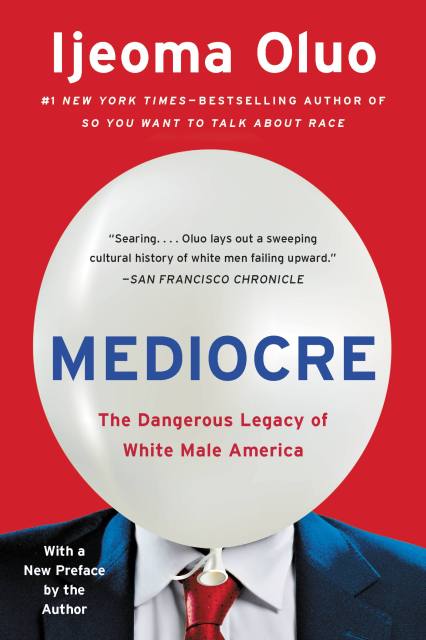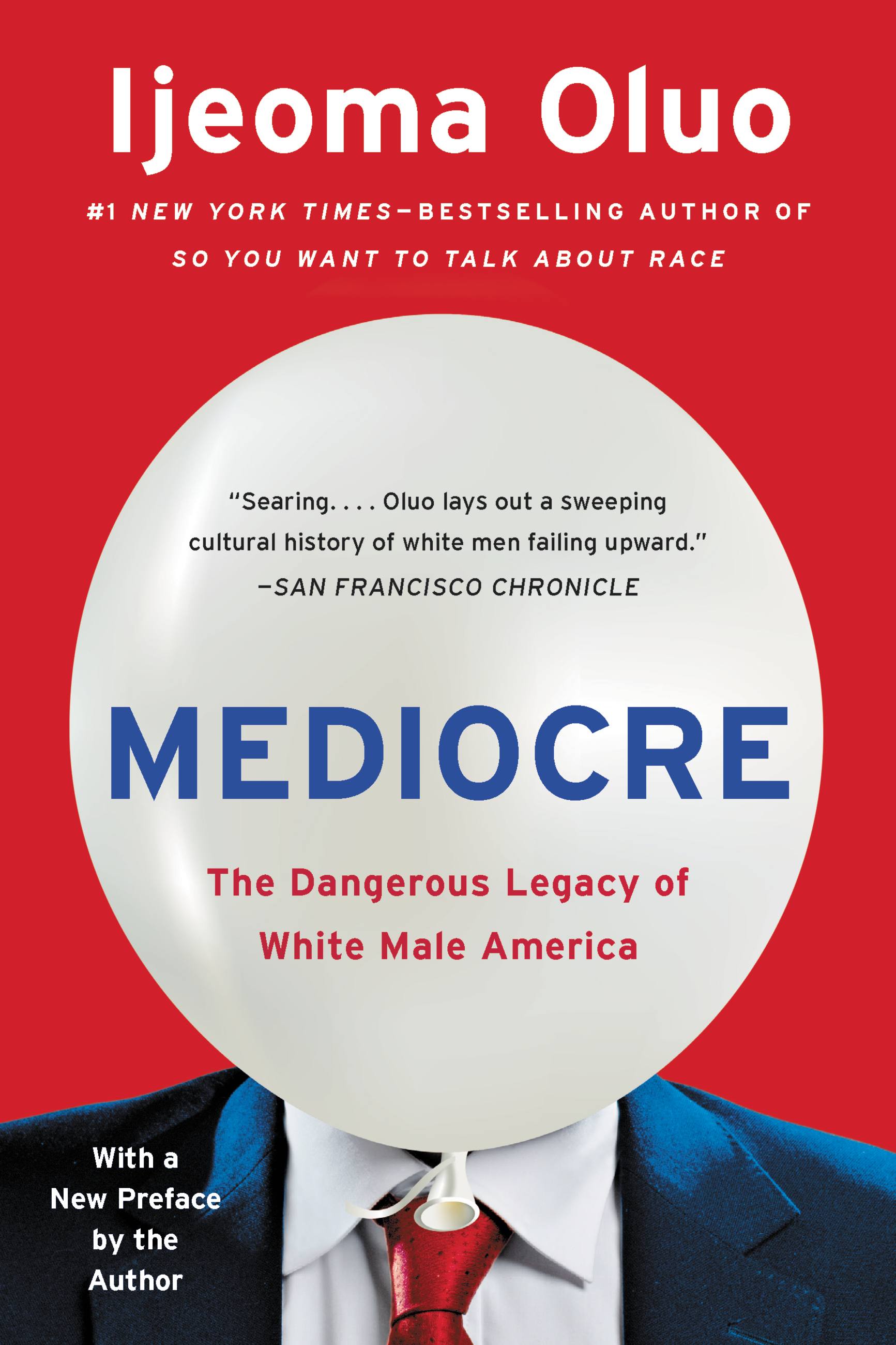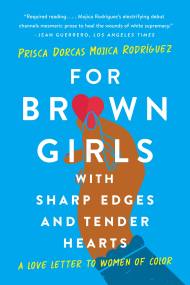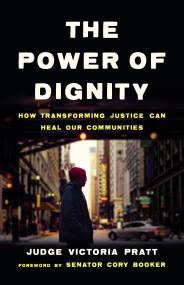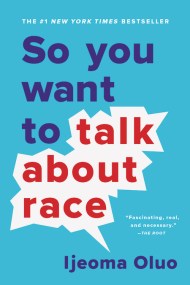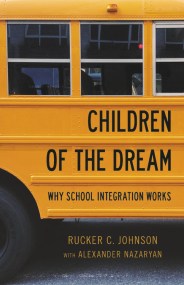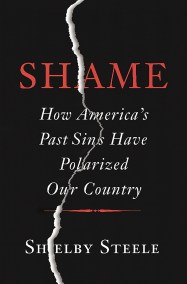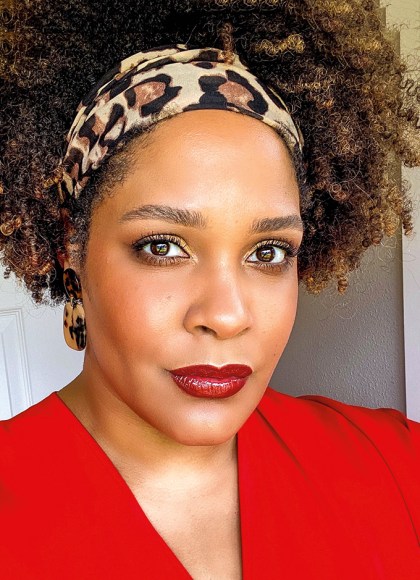Promotion
Use code MOM24 for 20% off site wide + free shipping over $45
Mediocre
The Dangerous Legacy of White Male America
Contributors
By Ijeoma Oluo
Formats and Prices
Price
$17.99Price
$22.99 CADFormat
Format:
- Trade Paperback $17.99 $22.99 CAD
- ebook $12.99 $16.99 CAD
- Hardcover $28.00 $35.00 CAD
- Audiobook Download (Unabridged) $27.99
This item is a preorder. Your payment method will be charged immediately, and the product is expected to ship on or around November 9, 2021. This date is subject to change due to shipping delays beyond our control.
Also available from:
What happens to a country that tells generation after generation of white men that they deserve power? What happens when success is defined by status over women and people of color, instead of by actual accomplishments?
Through the last 150 years of American history — from the post-reconstruction South and the mythic stories of cowboys in the West, to the present-day controversy over NFL protests and the backlash against the rise of women in politics — Ijeoma Oluo exposes the devastating consequences of white male supremacy on women, people of color, and white men themselves. Mediocre investigates the real costs of this phenomenon in order to imagine a new white male identity, one free from racism and sexism.
As provocative as it is essential, this book will upend everything you thought you knew about American identity and offers a bold new vision of American greatness.
Genre:
-
“Wide-ranging in the cultural history it provides, Mediocre illuminates the various ways white men work to maintain racial power.”New York Times
-
"A conversational call to action, an urging to rewrite our definition of White manhood and diminish the power it holds…. Oluo is asking us to evaluate the myths America tells itself about itself, see the violence within, be honest about the perpetrators and the victims, and then tell different stories. Truer ones. But she is also inviting us, on occasion, to chuckle. There is levity and voice in Mediocre.”Washington Post
-
"Searing.... Oluo lays out a sweeping cultural history of white men failing upward, from education to sports to politics.... Mediocre is a fast, engaging read, and Oluo is a warm, evenhanded narrator."San Francisco Chronicle
-
“I’m eternally grateful, as I think everyone is who reads your book. Your books don’t come from a place of hate, but of determination to make a change... Thank you for writing another amazing book.”Trevor Noah, on "The Daily Show"
-
“Oluo examines the cultural and political underpinnings of what she calls the 'mediocre-white-man-industrial complex.' ... She also digs into how, at different points in history, this country has failed women—a particularly salient reminder amid a pandemic that has driven hundreds of thousands of women out of the workforce.”Fast Company
-
“Oluo takes readers on a journey through 150 years of American history, from the post-reconstruction South to present-day controversy over NFL protests, all while pointing out the influence and costs of white male supremacy.”Katie Couric
-
"Ijeoma Oluo's sharp yet accessible writing about the American racial landscape made her 2018 book, So You Want to Talk About Race, an invaluable resource for anyone looking to understand and dismantle racist structures. Her new book, Mediocre, builds on this exemplary work, homing in on the role of white patriarchy in creating and upholding a system built to disenfranchise anyone who isn't a white male."TIME
-
“Redefines the idea of American greatness”Cosmopolitan
-
“This well-researched, yet highly personal, tome shines a spotlight on modern-day racism and white supremacy.”USA Today
-
“As Ijeomo Oluo puts it in her new book Mediocre: The Dangerous Legacy of White Male America, “By defining greatness as a white man’s birthright, we immediately divorce it from real, quantifiable greatness—greatness that benefits, greatness that creates.” Make America Great Again can be assumed to be about the former kind of greatness, and it was always a promise that greatness meant this long era of inequality. Inequality is the central platform of the right and Trumpism.”Rebecca Solnit, for LitHub
-
“Oluo’s ability to clearly and directly address the country’s most intractable and thorny issues of racism and misogyny have garnered her a legion of fans across the country and around the world.... Addressing head-on the elephant in America’s living room, Oluo uses a wealth of historical research to support her argument that our country’s default mode of propping up and centering white men not only doesn’t serve us, but is actively destructive.... she challenges us to imagine a different way—a new path that maximizes the potential of every person, that doesn’t waste the incredible talents and contributions of women and people of color.”Seattle Times
-
“With its provocative title and blunt dissection of race and privilege, Mediocre could be one of the season’s most important conversation starters.”Philadelphia Inquirer
-
“The history of white male entitlement masquerading as meritocracy is a long one. In her follow-up to So You Want to Talk About Race, Oluo explains how understanding that entitlement is a necessary first step to dismantling a system built on oppression and exploitation, and the “violent, sexist, racist status quo.”Toronto Globe & Mail
-
“This historical look at white male America explores the socioeconomic and political ways racism and sexism have shaped our country to protect white male power. Even further, it considers how that grip on power has stood in the way of happiness and liberty for all Americans.”BookRiot
-
“We all joke about having the confidence of a mediocre White man, but New York Times–bestselling author Ijeoma Oluo breaks down what this really means in her new book. Your ultra average, angry White man didn’t happen by accident. Oluo methodically identifies and explains the structures that create, multiply, and embolden him.”Zora
-
“Puts patriarchy on blast”BUST
-
"Oluo examines how white male supremacy permeates and shapes almost every facet of our lives, and ultimately asks us to imagine a white manhood that is not based in the oppression of others."PAPER
-
“Deftly weaving past and present… Each case study reveals how well-trodden American tropes of “meritocracy” and “rugged individualism” have served as sneaky myths covering up the real workings of white male supremacist power and oppression, reinforcing the false image of white American men as supermasculine heroes while blaming marginalized groups for their own dispossession and dehumanization."Bitch
-
“Oluo's newest book examines how the privilege afforded to white men in western culture has made the world more dangerous for us all. Although it's tempting to believe that Donald Trump is the worst product of this trend, rest assured: Trump is only the most visible."Bustle
-
“In Oluo’s characteristic incisive prose, she details how much white men’s undue influence in the US has cost the country and its people socially, economically, and politically.”Autostraddle
-
“If the title of this book makes you uncomfortable, then that means you should probably read it. Oluo excavates the legacy of white male power and how our culture and systems have and continue to uphold it.”WBUR's "Artery"
-
“Reading history-rich analysis of white male supremacy and its toxic repercussions from the author of So You Want To Talk About Race on the same week that the living personification of white grievance stormed the U.S. Capitol was like finding the key in the back of a fantasy novel: Suddenly, the labyrinthine gibberish started to make sense.”A.V. Club
-
“Oluo is clear and approachable—a lucid teacher, leavening lessons with snark. As I (white guy) read the book, I was again disoriented by how much Oluo’s been harassed for her supposedly ‘antiwhite’ writing.... Oluo’s case is compelling. America has long been telling a bad story, one that manifests in movies, in presidencies—that white men are heirs to the kingdom, regardless of their abilities. It’d do us well to realize when we’ve been sold a lie.”Seattle Met
-
“Using statistics, anecdotal evidence and persuasive eloquence, Oluo depicts a world where white male supremacy harms us all.”Entropy
-
“Ijeoma Oluo’s look at the history of white male mediocrity in America feels like it is coming out at the perfect moment…and I know I will be referencing it for many years to come.”Hey, Alma!
-
“A gifted storyteller and thorough researcher... with solid scholarship and useful pop culture references... [Oluo has written] a bold, incisive book on heavy topics with a call to action for a more equitable future that doesn’t center White men.”Kirkus
-
“Erudite yet accessible, grounded in careful research as well as Oluo’s personal experiences of racism and misogyny, this is an essential reckoning with race, sex, and power in America."Publishers Weekly
-
“Whose America is it? Oluo makes the case that whiteness and masculinity are powerful yet also dependent on the identities that they oppress. Outstanding chapters scrutinize the anger and fervor of Bernie Bros, resentment toward women in politics, right-wing attacks on higher education, and even the origins of football."Library Journal
-
“Oluo expertly shows how inequality, toxic masculinity and an unequal power structure deeply hurt all Americans, including white men. Through careful research and scholarship, she breaks down the system that sustains the status quo while shedding light on the ways others can also dismantle this system to ensure a more equitable future for all. It’s an essential read.”Bookpage
-
“Oluo draws clear lines from the mythmaking of “Buffalo Bill” Cody—who recast himself as a hero after scalping a Cheyenne warrior in a fight—to George Preston Marshall’s ardent and determined resistance to desegregating his NFL team, which he named the Redskins as an act of racist defiance. Oluo persuasively argues that the result of leaving power in the hands of men like Cody and Preston is not equal, fair, or even advantageous. Mediocre is an eloquent and impassioned plea for the moral and practical value of pursuing a more just future.”Booklist
-
"A conversational call to action, an urging to rewrite our definition of white manhood and diminish the power it holds. Oluo is asking us to evaluate the myths America tells itself about itself, see the violence within, be honest about the perpetrators and the victims, and then tell different stories. Truer ones. But she is also inviting us, on occasion, to chuckle. There is levity and voice in Mediocre.”Washington Post Book World
-
"Ripped, tragically, from yet another and another and another set of headlines, Mediocre: The Dangerous Legacy of White Male America breaks ground and forces a bold, startling, and necessary conversation about the implications of institutional supremacy, and its crushing impact on people of color and women."Patrisse Khan Cullors, Co-founder Black Lives Matter, New York Times bestselling author of When They Call You a Terrorist, Joint recipient of The Sydney Peace Prize
-
"Oluo masterfully diagnoses the pervasive plague of white mediocrity. Mediocre serves as a call to action for every person, regardless of race or gender, to actively resist white male mediocrity's hold."Kimberlé Crenshaw, Executive Director, African American Policy Forum, and Professor, UCLA and Columbia Law Schools
-
"Oluo is one of our great voices and Mediocre not only educates us, but it inspires us all to act and change the world for the better. But first, I need to read this book again. It's just that damn good."Phoebe Robinson, New York Times bestselling author of You Can't Touch My Hair
-
"There is no one more adept at parsing the toxic effects of white male privilege and systemic oppression than the immensely talented Ijeoma Oluo. Her brilliant book is a master class in understanding how systems of domination working relentlessly in the service of white male patriarchy not only harm all women and people of color, but ultimately hinder white men themselves from reaching greatness."Michael Eric Dyson, New York Times bestselling author of Long Time Coming
-
"Ijeoma's revelatory and visionary new book confronts disturbing hidden histories that vibrate throughout our institutions and communities today. The connections and insights in Mediocre make it an essential read."Austin Channing Brown, New York Times bestselling author of I'm Still Here
-
"Mediocre offers profound truth in service of liberation. It cuts to the heart of white male supremacy, a system that is life-destroying for people of color and even for white men ourselves."Matt McGorry, Actor, How To Get Away With Murder and Orange is the New Black, Activist, and Co-Founder of Inspire Justice
-
"In her illuminating new book, Ijeoma Oluo unpacks how 'mediocrity' is a privilege created and perpetuated by our obsession with white male superiority. Oluo deftly balances the cultural history of white western male myth-making with contemporary cultural criticism of the aggrieved white American man. It is a deft and thought-provoking book that contextualizes public discourse on race, class, and gender in America."Tressie Mcmillan Cottom, author of the National Book Award Finalist Thick
-
"Once again, Ijeoma Oluo uses her elegant voice to speak directly to the root issues at the core of the United States' seeming inability to reconcile who we have been with who we had hoped to be. This book goes beyond how we got here, and digs into where we are, what we're going to do about it, and what's at stake if the people with the most power refuse to do better."Ashley C. Ford, writer
-
"Mediocre is urgent, powerful, and laced with an acidity that forces us to contend with our own complicity in a culture that systematically oppresses women, people of color, and especially, women of color. America is a nation that aspires to greatness, but refuses to acknowledge how its laws and conventions instead protect white male mediocrity. Both So You Want to Talk About Race and Mediocre are necessary reads, because few writers are as vital to understanding our present moment as Oluo."Jeff Yang, author, CNN contributor, and cohost of the podcast They Call Us Bruce
-
"Oluo skillfully weaves each argument with history none of us ever learned in school, making a strong case for how we got here and how we can get out."Fast Company, Books We Can’t Put Down This Summer
-
"An engaging mix of American history, political analysis, and social commentary, brought to life through stories of her experience as a Black woman...Mediocre is not a threat to White guys but a gift, offering the social/political tough love that we need to see society—and ourselves—more clearly."YES! Magazine
- On Sale
- Nov 9, 2021
- Page Count
- 336 pages
- Publisher
- Seal Press
- ISBN-13
- 9781580059527
Newsletter Signup
By clicking ‘Sign Up,’ I acknowledge that I have read and agree to Hachette Book Group’s Privacy Policy and Terms of Use
